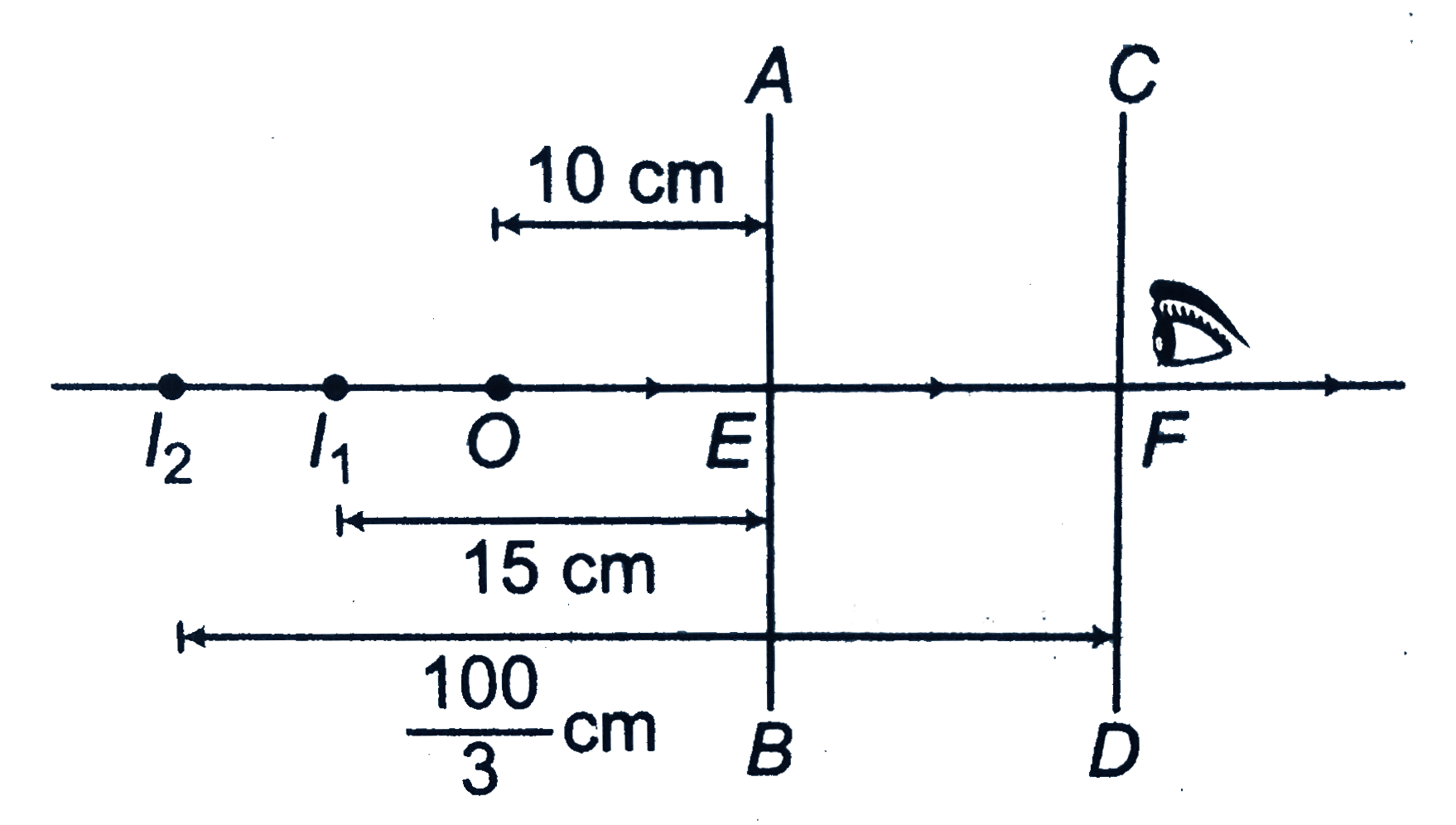In Fig, find position of second image I2 formed after two times refraction from two place surfaces AB and CD.

We will apply v=μ2μ1u, two times with using the fact that object and image are on same side of the surface.
Refraction from AB
μ1=1
μ2=1.5
u=EO=10cm (towards left of AB)
v=(μ2μ1)u=1.51(10)
or v=EI1=15cm (towards left of AB)
Refraction from CD I1 will act as an object for refraction from CD
μ1=1.5 and μ2=2
u=FI1=FE+EI1=(10+15)
=25cm (towards left of CD)
v=(μ2μ1)(u)=(21.5)(25)
=1003 cm (towards left of CD)
=FI2
The correct figure is as shown below

Topper's Solved these Questions
- REFRACTION OF LIGHTBook:DC PANDEYChapter:REFRACTION OF LIGHTExercise:Example Type 10
Explore 1 Video
- REFRACTION OF LIGHTBook:DC PANDEYChapter:REFRACTION OF LIGHTExercise:Example Type 11
Explore 3 Videos
- REFLECTION OF LIGHTBook:DC PANDEYChapter:REFLECTION OF LIGHTExercise:Subjective
Explore 9 Videos
- SEMICONDUCTORSBook:DC PANDEYChapter:SEMICONDUCTORSExercise:Subjective
Explore 12 Videos
Similar Questions
An object is placed 10cm away form a glass piecwe (n=1.5) of length 20cm bounded by spherical surfaces of radii of curvaure 10cm. Find the position of final image formed after two refractions at the spherical surfaces.

View SolutionAn extended object of size 2cm is placed at a distance of 10cm in air (n=1) form pole, on the other side of refracting surface has refractive index n=2. Find the positon, nature and size of image formed after single refraction through the curved surface.

View Solution
Knowledge Check
An extended object of size 2 cm is placed at a distance of 10 cm in air (n = 1) from pole, on the principal axis of a spherical curved surface. The medium on the other side of refracting surface has refractive index n = 2. Find the position, nature and size of image formed after single refraction through the curved surface.
 A30 cm from pole in the medium of refractive index 1, virtual, erect and 4 cm in size.B40 cm from pole in the medium of refractive index 1, virtual, erect and 4 cm in size.C40 cm from pole in the medium of refractive index 1, real, inverted and 4 cm in size.D30 cm from pole in the medium of refractive index 1, virtual, erect and 6 cm in size.
A30 cm from pole in the medium of refractive index 1, virtual, erect and 4 cm in size.B40 cm from pole in the medium of refractive index 1, virtual, erect and 4 cm in size.C40 cm from pole in the medium of refractive index 1, real, inverted and 4 cm in size.D30 cm from pole in the medium of refractive index 1, virtual, erect and 6 cm in size.A parallel narrow beam of light is incident on the surface of a transparent hemisphere of radius R and refractive index μ=1.5 as shown. The position of the image formed by refraction at the image formed by refraction at the spherical surface only as
 AR2B3RCR3D2R
AR2B3RCR3D2RThe image for the converging beam after refraction through the curved surface is formed at
 A40 cmB403 cmC20 cmD1807cm
A40 cmB403 cmC20 cmD1807cm
Find the position of the image formed by the lens combination given in Fig.
 .
.
View Solution
Plane surface of a thin planoconvex lens reflects 50% of light, while the curved surface is completely transparent, if final image of O after refraction through lens coinsides with the image formed due to partial reflection from plane surface. if distance (in m) between O and lens is x then find x/4
View SolutionA region bounding water has air on two sides. Tell the nature (real or virtual) of the image for following cases- (The object is real and lies on the principal axis (see fig) in all cases.)
(a) The object is to the left of surface 1 and the image to be considered is formed after the first refraction.
(b) The object is to the left of surface 1 and the image to be considered is formed after two refractions.
(c) The object is to the right of second surface and the image to be considered is formed after one refraction.

View SolutionAn insect at point 'P' sees its two images in the water mirror system as shown in the figure. One image is formed due to direct partical reflection from water surface and the other image is formed due to refraction, reflection & again refraction by water mirror system in order. Find the separation (in cm) between the two images. Mirror M has focal length 60 cm [Takeμw=4/3]

View SolutionFigure shown objectO.Final image I isformed after two refraction and one refraction is also shown in figure .Find the length of mirror.(in cm).

View Solution
